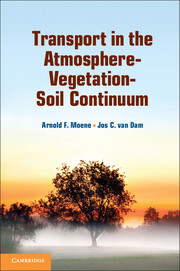Book contents
- Frontmatter
- Contents
- Preface
- 1 The Atmosphere-Vegetation-Soil System
- 2 Available Energy: Net Radiation and Soil Heat Flux
- 3 Turbulent Transport in the Atmospheric Surface Layer
- 4 Soil Water Flow
- 5 Solute Transport in Soil
- 6 Vegetation: Transport Processes Inside and Outside of Plants
- 7 Combination Methods for Turbulent Fluxes
- 8 Integrated Applications
- 9 Integrated Models in Hydrology and Meteorology
- Appendix A Radiation
- Appendix B Thermodynamics and Water Vapour
- Appendix C Dimensional Analysis
- Appendix D Microscopic Root Water Uptake
- Appendix E Crop Factors for Use with Makkink Reference Evapotranspiration
- Answers
- List of Main Symbols
- References
- Index
8 - Integrated Applications
Published online by Cambridge University Press: 05 June 2014
- Frontmatter
- Contents
- Preface
- 1 The Atmosphere-Vegetation-Soil System
- 2 Available Energy: Net Radiation and Soil Heat Flux
- 3 Turbulent Transport in the Atmospheric Surface Layer
- 4 Soil Water Flow
- 5 Solute Transport in Soil
- 6 Vegetation: Transport Processes Inside and Outside of Plants
- 7 Combination Methods for Turbulent Fluxes
- 8 Integrated Applications
- 9 Integrated Models in Hydrology and Meteorology
- Appendix A Radiation
- Appendix B Thermodynamics and Water Vapour
- Appendix C Dimensional Analysis
- Appendix D Microscopic Root Water Uptake
- Appendix E Crop Factors for Use with Makkink Reference Evapotranspiration
- Answers
- List of Main Symbols
- References
- Index
Summary
This chapter shows how the knowledge from the previous chapters can be combined to understand and manage processes at the land–atmosphere interface. First, attention is paid to the estimation of crop water requirements using the crop factor method and to the direct measurement of evapotranspiration using lysimeters. Then it is shown how in a semiarid region the water productivity of irrigated crops can be studied and improved. Finally, the response of different vegetation types (grass and forest) to heat wave conditions is studied.
Crop Water Requirements
Evapotranspiration determines to a large extent the hydrological cycle and the environmental conditions near the soil surface. There is a direct relation between the ratio of actual to optimal transpiration and the ratio of actual to optimal crop yield. Irrigation water requirements are determined by the amount of evapotranspiration relative to the amount of natural rainfall and readily available soil moisture. Groundwater recharge and soil salinization also depend largely on the amount of evapotranspiration. In the context of agricultural practice the water required to grow a crop does not only include the water loss due to evapotranspiration, but also the water needed to leach salts and to compensate for nonuniform application of the water (Allen, 1998).
- Type
- Chapter
- Information
- Transport in the Atmosphere-Vegetation-Soil Continuum , pp. 278 - 301Publisher: Cambridge University PressPrint publication year: 2014



